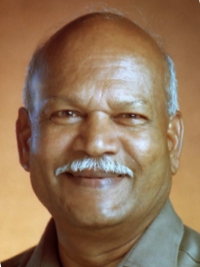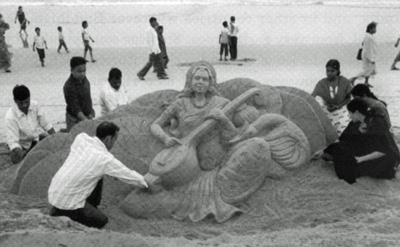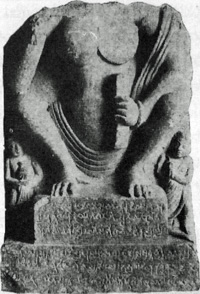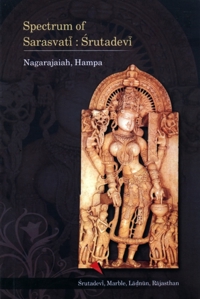 |
[6] Kellaputtige South Kanara |
Sarasvatī
Sarasvatī is giver of boons of speech, eloquency, knowledge, health, music, wisdom and arts.
Sarasvatī as an embodiment of knowledge, music and art, is entrenched in Indian psyche, irrespective of religious affiliation.
Poet Mallisena (1047 C.E.) appropriately says that Sarasvatī is the common heritage of all Indian religions.
Sānkhya-Vedāntika-Cārvāka-Mīmāmsa-Digambaraḥ
Sauagatastepi devi tvam dhyāyanti jñāna-hetave.[Malliṣeṇa, BhairavaPadmāvatī-kalpa, appendix 12]
Sarasvatī was known and revered in all religions of India, and in other countries wherever Buddhism had spread, from very early times. She was conceptualized in the last centuries of bee and early centuries of CE. In the beginning she was visualised as a riverine goddess of knowledge, and the iconography of identified early images support this view.
[7] Śobhāyātre
Sarasvatī has many aliases and such variants include Satarūpa, Sāvitrī, Gāyatrī, Brahmānī, Laksmī, Gaurī, Medhā, Dharā, Pusti, Gaurī, Tustī, Prabhā, Bhāratī and Mati. Similarly her name is assigned to Devī, Umā etc. These different names are reasonant of varied traditions and times.
Etymologically and semantically the rendering of Sarasvatī's name by translation would mean 'she who is watery' (saras-). But, the rendering of her name by ajahallakṣaṇe, metonymy, the original meaning was extended to indicate her role as deity of knowledge and arts.
Images of Sarasvatī are found in hundreds of temples and the famous temple at Śṛṅgeri (Cikkamagaḷūr. Dt.) is dedicated to goddess Sarasvatī. The Sarasvatī temple at Gadag is an architectural marvel of the twelfth century. In the Tuḷunāḍu Navarātri-Utsava, Festival of nine-nights, is popular. During this period Śāradādevi is worshipped in all temples and on the final day the image of goddess Sāradā is taken in a procession called Śobhāyātre, 'procession of beauty'. Similarly the annual festival of Sarasvatī is observed in Bengal and Orissa States.
[8] Sarasvatī and haṁsa, made of sand on the sea-shore, Puri, Orissa.
Courtesy: Prajāvāṇi
Sarasvatī's dominant, distinguishing iconographic features are pustaka, vīṇā, akṣamālā (s.a. akṣamāni, akṣasūtra), kamaṇḍalu, and her mount haṁsa or mayūra.
Sarasvatī was conceptualized and evolved methodically: 'there are numerous factors which contributed to the development of Sarasvatī into a goddess of music: the sound of the river's flowing waters, her identification with Speech, the recitation of the Vedas, Vac's choice to remain with the vīṇā-playing gods in the myth of the Barter for Soma, and the expansion of her territory to all fields of knowledge, to name but the most relevant points' [Ludvik 230].
Early works like the Vyākhyā-prajnapti (c. 2nd cent. CE), Sivaśarma's Pakṣikasūtra, (c. 5th cent. CE), Simhasūri Kṣamāśramaṇa's (675 CE) Dvādaśāraṇya-Cakravṛtti, Haribhadrasūri's (775 CE) Saṁsāra-dāvānala stotra and Pañcāśaka, Bappabhaṭṭi sūri's Caturviṁśathā (743-838 CE), and Mahāniśitasūtra and the Śāradāstotra etc., eloquently endorse the extensive worship of Sarasvatī from ancient times in the Jaina tradition. The Jains took a leap forward in their conception of goddess of knowledge by elevating her to the status of Śrutadevī.
Art experts have discussed about the identification of the earliest extant Sarasvatī images. In this context there are some images which were wrongly noticed as the prototype of Sarasvatī.
Mostly concentrating on pre-eighth century material on Sarasvatī, Catherine Ludvick (2007) has made an extensive study of corresponding textual sources and iconographic developments. She has also examined some erroneously identified and mistakably dated images:
a. The Bhārhut (eastern M.P.) figure, carved on the southern pillar of the Stūpa railing, now preserved in the Indian Museum, Kolkata, stands atop a full-blown lotus growing from a lake, and carries a stringed instrument. The belief that this relief is of Sarasvatī is not tenable. The deities cannot be identified on the basis of their musical instruments alone, because different goddesses carry vīṇā, or akṣamālā, or kamaṇḍalu.
b. Ghaṇṭaśāla (Āndhra Pradesh) image of Sarasvatī was noticed by Alexander Rea during his excavations in 1892. The four-armed sculpture figures on one of the marble slabs. Since a Buddhist stūpa existed at the excavated site, scholars suggested that the image is a Buddhist Sarasvatī and belonged to the second century bee and hence is the oldest image so far discovered. Albeit, after matured consideration, Catherine Ludvik has rightly observed that the image can not be assigned a date earlier than the seventh century CE [2007: 229].
c. The female figure, in the Lahore Museum, seated on a lion and playing a lute (a kind of vīna), and whose head is missing, erroneously identified as goddess Sarasvatī. Lion is not her mount.
d. The female figure on the reverse of king Samudragupta's (350-75 CE) coin has drawn the attention of scholars. Seated on a wicker stool and wearing a cap, she holds a fillet and a horn of plenty. However, she cannot be identified as Sarasvatī.
e. The identification of the female figure, with haṁsa at her feet and standing in three-bends on a lotus, on the reverse of Vaṅga king Samācāradeva (550-75 CE) has posed a problem. In the absence of book, vīṇā and rosary in her arms, the figure could be Lakṣmī.
Let us know about the earliest surviving image of Sarasvatī from Mathurā excavations which was first noticed by A. Führer on January 18, 1889, at the historic Jaina site where more than two magnificent Jaina temples once flourished.
The Mathurā excavations yielded 157 ancient sculptures and inscriptions, and according to Heinrich Luder's computation, 89 among 157 are of Jaina affiliation. The cult of Sarasvatī developed first in the Jaina tradition. She frequently figures in the Jaina plastic art. Mathurā (Uttar Pradesh) has supplied three significant Sarasvatī sculptures including the oldest known one. The earliest extant image of Sarasvatī, dated 132CE also belongs to Jaina tradition [No. 24, Museum, Lucknow]. Text of the dedicatory inscription on the two-tired rectangular pedestal of the image is in Brāhmi script:
- (Sid)dhaṁ sava 504 hemaṁtamāse Catu(r)t th(e) 4 divas(e) 10 a-
- Sya purvvāyām koḷeyāto ganāto sathānīyāto kulāto
- Vairāto śākhāto śrīgṛh(ā)to sambhogāto vā cakasyāryya
- (gha)sta (or u) hastiṣya śisyo ganisya aryya
māghahastisya śraddhacaro vācakasya a-- ryya devasya nirvvarŧtana govasya sīhaputrasya lohikakarakasya dānaṁ
- sarvvasatv(ā)n(ā)ṁ hitasukhā ekasarasvatī pratiṣṭhāvitā stavatale (na) dānavato
- dha(r) me(e?)
 Prof. Dr. Nagarajaiah Hampana
Prof. Dr. Nagarajaiah Hampana



